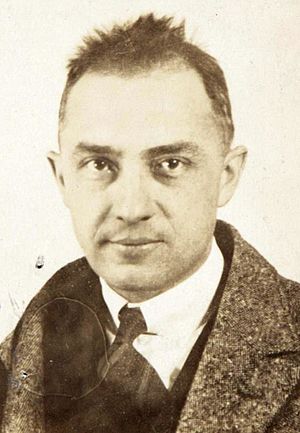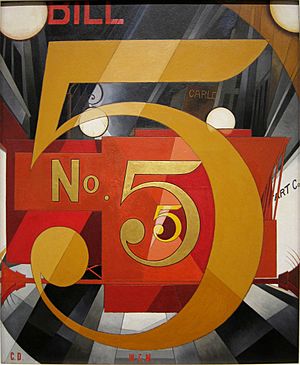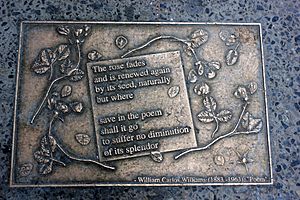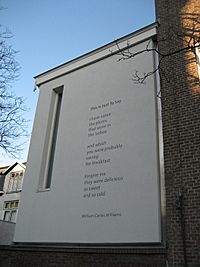William Carlos Williams facts for kids
Quick facts for kids
William Carlos Williams
|
|
|---|---|

Williams in 1921
|
|
| Born | September 17, 1883 Rutherford, New Jersey, U.S. |
| Died | March 4, 1963 (aged 79) Rutherford, New Jersey, U.S. |
| Occupation | Writer, physician |
| Alma mater | University of Pennsylvania |
| Literary movement | Modernism, Imagism |
| Notable works | "This Is Just to Say" "The Red Wheelbarrow" "The Great Figure" Paterson Spring and All |
| Spouse |
Florence Herman
(m. 1912) |
William Carlos Williams (born September 17, 1883 – died March 4, 1963) was an American poet, writer, and doctor. He is known for his connection to modernism and imagism, which were new styles of writing at the time.
Besides his writing, Williams worked for many years as a doctor. He treated both children and general patients. He was the chief of pediatrics (children's doctor) at Passaic General Hospital from 1924 until he passed away. This hospital, now called St. Mary's General Hospital, has a special plaque honoring him. It says, "We walk the wards that Williams walked."
Contents
Early Life and Education
Williams was born in Rutherford, New Jersey, in 1883. His father, William George Williams, was from England. His mother, Raquel Hélène Hoheb, was from Mayagüez, Puerto Rico. Her family was of French background.
Experts say that his family's Caribbean culture greatly influenced Williams. His parents spoke Spanish at home. Young William Carlos learned Spanish first. He started speaking English mostly when he was a teenager. Even though he wrote in English, his early life was shaped by Caribbean customs. This gave him a unique view of the world.
Williams went to school in Rutherford until 1897. Then, he studied for two years in Switzerland and Paris. When he came back, he attended the Horace Mann School in New York City. In 1902, he was accepted into the medical school at the University of Pennsylvania. He graduated from medical school in 1906.
After graduating, Williams worked as an intern at two hospitals in New York. He then went to Germany to study pediatrics further. In 1909, he published his first book of poems, called Poems.
Family and Writing Career
Williams married Florence ("Flossie") Herman in 1912. They moved into a house in Rutherford, New Jersey, where they lived for many years. Soon after, his second book of poems, The Tempers, was published. His friend Ezra Pound helped him publish it in London.
Around 1914, Williams and his wife had their first son, William E. Williams. Their second son, Paul H. Williams, was born in 1917. Their first son also became a doctor.
Even though he was a family doctor, Williams had a very successful career as a poet. He loved painting, and his writing often showed this interest. Besides poetry, he also wrote short stories, plays, novels, essays, and translations. He worked as a doctor during the day and wrote at night.
Early in his career, he was part of the Imagist movement. This was a style of poetry that focused on clear, sharp images. He became friends with other poets like Pound and H.D. through his medical studies. However, he soon developed his own ideas. His style changed to focus on showing his local environment in a new, modern way.
Later Life and Influences
In 1923, Williams published Spring and All. This was one of his most important poetry books. It included famous poems like "By the road to the contagious hospital," "The Red Wheelbarrow," and "To Elsie."
Around this time, another poet, T. S. Eliot, published The Waste Land. This poem became very popular and overshadowed Williams's different style of Modernism. Williams later wrote that Eliot's poem was a "great catastrophe" for American writing. While he respected Eliot's work, Williams did not like Eliot's complex style. Eliot often used foreign languages and references to old European literature. Williams preferred simple, everyday American English.
During the 1930s, Williams started working on an opera. It was called The First President and was about George Washington. Williams wanted it to help people understand what America was like at that time.
Williams wrote a long poem called Paterson. It was published between 1946 and 1958. This poem is like a collage, telling the story of the history, people, and spirit of Paterson, New Jersey. In Paterson, Williams explored the role of a poet in American society. He famously said, "No ideas but in things." This meant he believed that ideas should come from real, everyday objects and experiences.
In his later years, Williams guided and inspired many younger poets. He had a big impact on several American poetry movements in the 1950s. These included the Beat movement and the New York School.
One of his most important relationships was with Allen Ginsberg, another poet from New Jersey. Williams even included some of Ginsberg's letters in his poem Paterson. He said one letter helped inspire a part of the poem. Williams also wrote the introduction for Ginsberg's first book, Howl and Other Poems, in 1956.
Williams had a heart attack in 1948. After 1949, he suffered several strokes. A stroke in 1953 caused severe depression. He stayed in Hillside Hospital in New York for four months. William Carlos Williams passed away on March 4, 1963, at his home in Rutherford. He was 79 years old. He was buried in Hillside Cemetery in Lyndhurst, New Jersey.
Williams's Poetry Style
Williams's main poetry collections include Spring and All (1923), The Desert Music and Other Poems (1954), Pictures from Brueghel and Other Poems (1962), and Paterson (1963). His most famous poem is "The Red Wheelbarrow." This poem is a great example of the Imagist style. Another well-known poem is "This Is Just to Say."
Williams is strongly linked to the American modernist movement. He wanted to create a unique American poetry style. He believed in using fresh, everyday language from America. He wanted to free poetry from older European styles. Williams said, "The purpose of an artist... is to take the life, whatever he sees, and to raise it up to an elevated position where it has dignity."
Williams wanted to invent a new American poetry. This poetry would focus on everyday life and ordinary people. He came up with the idea of the "variable foot." This was his way of deciding where to break lines in his poems. The Paris Review called it "a metrical device to resolve the conflict between form and freedom in verse."
One goal of his "variable foot" was to show the American rhythm in everyday language. He also used a style called "triadic-line poetry." In this style, he broke a long line into three parts. A good example is his love poem "Asphodel, That Greeny Flower."
Williams and Painters

The Great Figure
Among the rain
and lights
I saw the figure 5
in gold
on a red
firetruck
moving
tense
unheeded
to gong clangs
siren howls
and wheels rumbling
through the dark city.
William Carlos Williams 1920.
Williams's mother was a painter. She shared her love for art with her son. Williams also painted when he was younger. A painting by him is now in Yale University's Beinecke Library. He once said he would have liked to be a painter as much as a poet. For most of his life, Williams wrote about art and introduced exhibitions for his artist friends.
In 1915, Williams started spending time with a group of artists and writers in New York. They were called "The Others." This group included artists like Man Ray and Marcel Duchamp. Williams also became close friends with American artists like Charles Demuth and Charles Sheeler.
Williams supported new ways of seeing and creating art. However, he and his friends wanted to move away from simply copying European styles. In 1920, he started a magazine called Contact with his friend Marsden Hartley. They wanted to publish works that came from an artist's direct experience and sense of place. They believed art should not follow old rules.
This led to a style called Precisionism. This art style focused on sharp, clear images of modern life. Williams's poems sometimes reflected paintings in this style. For example, his poem "The Pot of Flowers" (1923) refers to Demuth's painting "Tuberoses" (1922), which Williams owned. In return, Demuth created his painting "I saw the figure 5 in gold" (1928) as a tribute to Williams's poem "The Great Figure" (1921).
Williams dedicated his collection Spring and All (1923) to Charles Demuth. After Demuth's early death, Williams dedicated a long poem, "The Crimson Cyclamen" (1936), to his memory.
Williams always thought of his poetry like a painter uses words. He said, "I've attempted to fuse the poetry and painting, to make it the same thing." He believed a poem's design and a picture's design should be similar. In his later work, like Pictures from Brueghel (1962), he wrote poems inspired by older painters. He felt these artists were solving similar problems to his own, but from a distance.
Awards and Honors
The U.S. National Book Award was restarted in 1950. Williams won the first National Book Award for Poetry. He won for the third volume of Paterson and his Selected Poems.
In 1952, Williams was chosen as the Consultant in Poetry for the Library of Congress. However, he was not allowed to serve his term. This was because of false accusations that he was part of a communist group. Williams hired lawyers to fight these claims. But he was never allowed to respond to his critics and never received an apology. The next year, he received the Bollingen Prize along with Archibald MacLeish.
In May 1963, after he passed away, Williams was given the Pulitzer Prize. This was for his book Pictures from Brueghel and Other Poems (1962). He also received the Gold Medal for Poetry from the National Institute of Arts and Letters. The Poetry Society of America gives out the William Carlos Williams Award every year. It honors the best poetry book published by a small, non-profit, or university press.
Williams's house in Rutherford is now a historic site. It is listed on the National Register of Historic Places. He was also inducted into the New Jersey Hall of Fame in 2009.
See also
 In Spanish: William Carlos Williams para niños
In Spanish: William Carlos Williams para niños
- List of Puerto Rican writers
- William Carlos Williams Center for the Performing Arts
- Epic poetry
- Latino poetry
- Puerto Rican poetry



